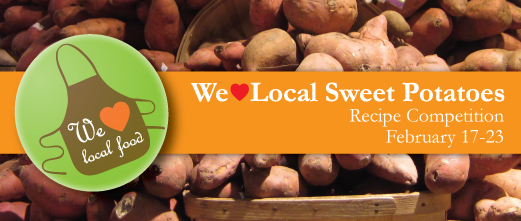Sweet Potato Soda
When you're asked to prepare a presentation on healthy, fizzy fermented beverages to an audience of people who care passionately about growing and eating local food, and it's February (February!) what are you to do? Seizing my courage last week, I took a look around the Produce department and freezer coolers and came up with a few ideas for my workshop at the NOFA Winter Conference - including sweet potato soda.
The basic principle for how I make most of my lacto-fermented sodas is the same: mash a couple of cups worth of fruit, add a soda culture (ginger bug or whey - click here to learn all about it), add a little sugar, and top it off with water and a half a lemon. (The lemon is mostly for good luck, as it creates a little acidity in the soda, favoring acid-loving bacteria like those beneficial microorganisms, the lacto-bacilli, who do the work of transforming the sugars in the fruit into healthy and tangy lactic acid). Would this method work for sweet potatoes?
This sweet potato soda was made with "Evangeline" sweet potatoes from Burnt Rock Farm, which have a particularly bright orange color. I wanted that color to come through in the soda, although in the end it was fairly subtle, meandering towards an earthy rather than cheery orange. The next time, I'll add a few slices of turmeric to make the colors pop. (I do something similar when I make a strawberry or raspberry soda in the summer, adding a few dried hibiscus blossoms to sharpen the red and add a base note of flavor).
The sweet potato soda recipe was adapted from Wild Fermentation, by fermentation guru Sandor Katz (who is coming to Burlington for the Food Systems Summit June 27th!). It's a traditional southern recipe, called Sweet Potato Fly in the South, and is additionally flavored with a few spices that evoke pumpkin pie - nutmeg, cinnamon, and mace. I love that local sweet potatoes aren't just for Southerners anymore, don't you?
These were some of the other sodas I brought to the NOFA conference (from left to right): Blueberry (far left), Strawberry-Rhubarb-Mint, Hibiscus-Rosehip, Grapefruit-Rosemary, Ginger-Orange-Turmeric, Apple-Cranberry, Beet, and Sweet Potato Soda.
They were full of fizzy goodness, much to the surprise and delight of the NOFA participants, who gamely tried beet soda (not their favorite), were intrigued by sweet potato soda (some people loved it), and who were equally divided between ginger and blueberry sodas as their favorite (tipping towards blueberry were those folks with freezers full of blueberries, who had just learned that you can make lacto-fermented soda in the wintertime out of frozen berries).
What's your favorite way to use local sweet potatoes? Enter the We ♥ Local Sweet Potatoes recipe competition now through February 23rd. Click below for more details!
Sweet Potato Soda
2 cups grated sweet potato
½ tsp. mace, stirred into ½ cup boiling water and allowed to cool
Pinch cinnamon
Pinch nutmeg
1/2-1 cup sugar (to taste)
1/4 cup whey (liquid from strained yogurt)
1/2 lemon, juice and peel
Rinse sweet potato very well under running water and press to remove as much starch as you can. Place in a half-gallon mason jar along with spices, sugar, whey, and lemon. Add water to fill the jar. Screw on lid and shake up well. Leave to ferment on the countertop for 2-5 days, until becoming tangy and slightly fizzy to your liking. (It's a good idea to keep it on a plate, because some soda might bubble over. Check it every day by stirring to release the CO2 and tasting to see how tangy it's becoming). When it's tangy to your liking, fill into 2 750ml bottles, or, if you want to dilute the flavor a little, into 2 1-liter bottles topped off with water. Screw on lids and allow to carbonate on countertop another few hours to 1-2 days. Refrigerate and enjoy!



